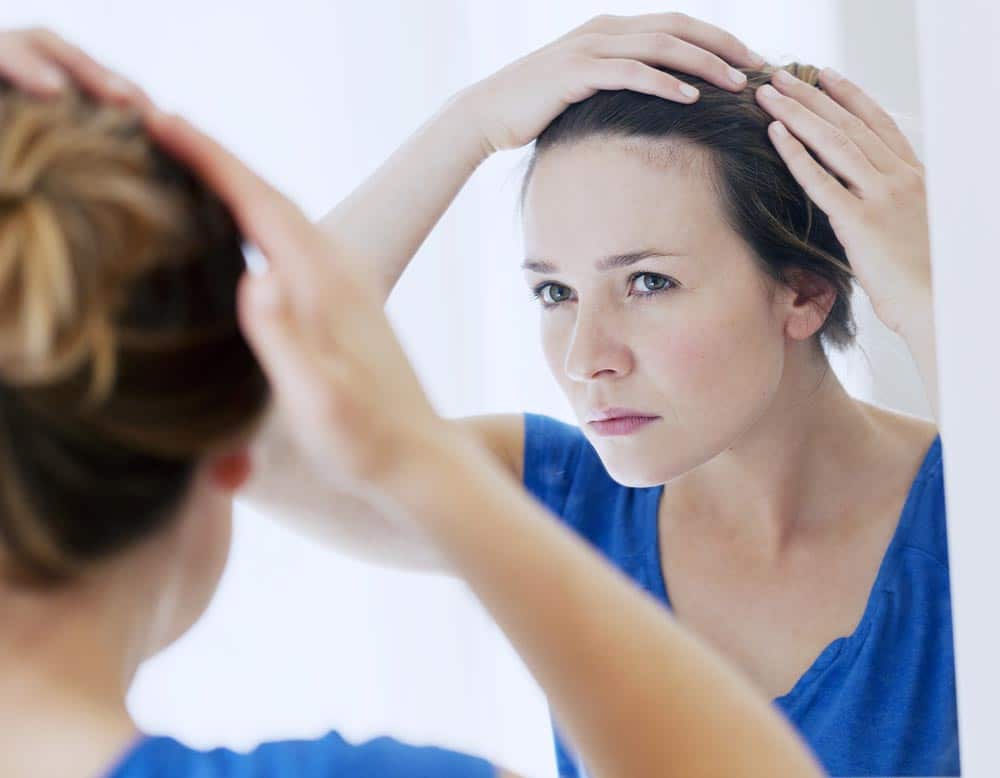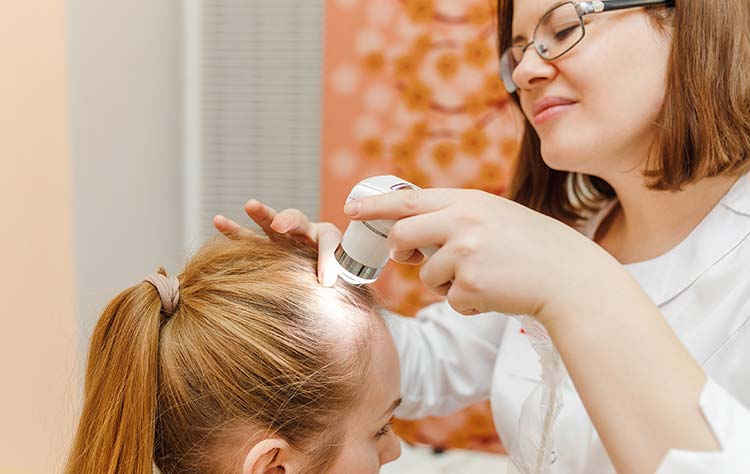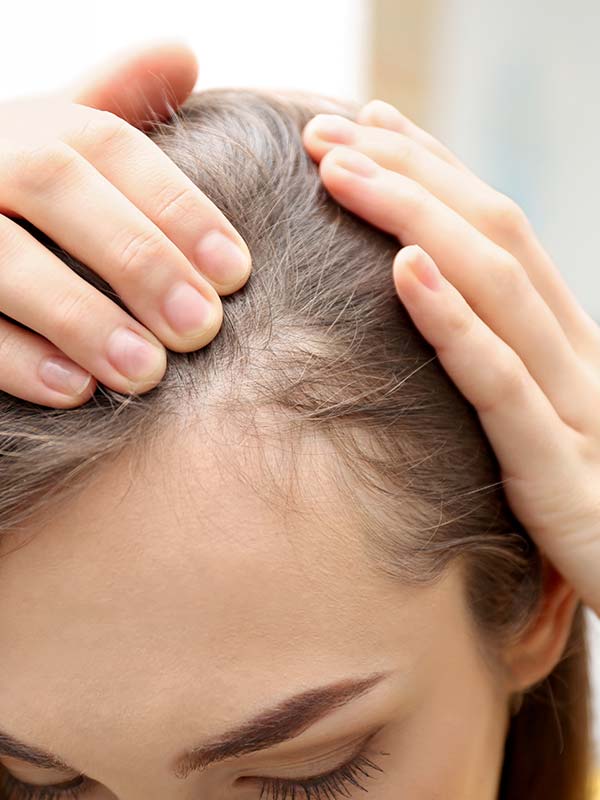Hair loss in women
Hair loss in women, also known as androgenetic alopecia. What helps against hair loss in women? We will take a closer look at the possible treatments and what causes them.

What is hair loss in women?
Hair loss in women is just that - when a woman experiences unexpected, severe hair loss. Generally, people lose between 50 and 100 individual hairs per day. Hair loss is part of a natural balance - some hairs fall out while others grow back. When the balance is broken - when hair falls out and less hair grows back - hair loss occurs. Hair loss is different from alopecia. The medical term for hair loss is "alopecia".
Hair grows on almost all skin surfaces - not on the palms of the hands, soles of the feet, lips or eyelids. Light, fine, short hair is called vellus hair. Terminal/androgenic hair is thicker, darker, and longer.
What are the cycles of hair growth?
The hair goes through three cycles:
- The Anagen phase (growth phase) can last from two to eight years. This phase generally refers to about 85% to 90% of hair on your head.
- The Catagen phase (transition phase) is the time during which the Hair Follicle shrink and last about two to three weeks.
- The Telogen phase (resting phase) lasts about two to four months. At the end of this phase, the hair falls out.
Your shorter hairs like eyelashes, arm and leg hair, and eyebrows have a brief anagen phase—about a month. Your scalp hair can last up to six years or even longer.
>> The best hair growth products for women test
What are the types of hair loss?
There are three: anagen effluvium, telogen effluvium and FPHL.
- Anagen effluvium : This is caused by drugs that poison a growing hair follicle (like chemotherapy).
- Telogen effluvium : This is achieved through an increased number of Hair follicles causing them to reach the telogen phase, in which hairs are drop out .
- Androgenetic alopecia / female pattern alopecia / female pattern hair loss (FPHL) / baldness : This type is the most common. The hair becomes thinner above the head and on the sides.
How common is hair loss in women?
Many people think that hair loss only affects men. However, it is estimated that more than 50% of women will experience noticeable hair loss. The most significant cause of hair loss in women is female pattern hair loss (FPHL), which affects about one-third of susceptible women, or about 30 million women in the US.
Which women experience hair loss?
Any girl or woman can be affected by hair loss. However, it is usually more common in:
- Women older than 40 years.
- Women who have just had babies.
- Women who had chemotherapy and those who were affected by other drugs.
- Women who often have hairstyles that pull on the hair (like tight ponytails or tight braids) or use harsh chemicals on their hair.
- Menopausal women.
What are the myths about hair loss?
Myths about hair loss are widespread. Nothing in the following list is true:
- You lose hair because you shampoo it too much or because you have coloured it or got a perm.
- Shed cause permanent hair loss in women.
- Stress causes permanent hair loss in women.
- When you shave your head, your hair grows back twice as thick.
- When you stand on your head, you increase blood circulation and stimulate the hair growth.
- Brushing your hair 100 times a day will make your hair healthier.
- Hats and wigs cause hair loss in women.
- Hair loss only affects intellectual women.
Hair loss causes in women

What are the most common causes of hair loss in women?
What Causes hair loss?
- Hairstyle: Your hairstyle can cause hair loss if your hair is arranged in a way that pulls at your roots, such as tight ponytails, braids or cornrows. This type of hair loss is called Traction alopecia is the term used. If the hair follicles are damaged, the loss can be permanent.
- Vitamin deficiency.
- Diet (rapid weight loss).
- Restrictive diets.
- Over-processed scalp hair (breakage).
What causes anagen effluvium hair loss?
- Toxic substances, including chemotherapy, radiotherapy and some medicines. These cause sudden hair loss that can occur anywhere on your body. It happens to hair in the growth phase. Sometimes this type of hair loss can be permanent if your hair follicles are damaged.
What causes hair loss in the telogen effluvium?
- Extreme physical stress or shock to your body: This causes temporary hair loss. This category includes events such as losing a lot of weight, surgery, anaemia, illness and child birth.
- Extreme emotional stress: mental illness, death of a loved one, etc.
- An abnormal thyroid gland.
- Medication and food supplements: blood pressure medication, gout medication and high doses of vitamin A.
- Hormone changes due to pregnancy, Menopause or birth control pills.
What causes FPHL (Female Pattern Hair Loss)?
- Genes: Your family's genes can cause hair loss on the top of your head.
- Ageing: Hormonal changes in old age can lead to baldness.
- Menopause: This type of hair loss often gets worse when estrogen is lost during menopause.
There are also some conditions that influence hair loss:
- Alopecia areata is an autoimmune skin disease that causes patchy hair loss on your head and possibly other parts of your body. It's usually not permanent.
What is the relationship between hair loss in women and menopause?
During the menopause, one of two things can happen to your hair. You might start growing hair where you didn't before. Or you may start to see hair that you have been thinning. One cause may be that hormone levels change during menopause. The levels of oestrogen and progesterone decrease, which means that the effect of androgens, the male hormones, is increased.
During and after menopause, hair can become finer (thinner) as the hair follicles shrink. The hair grows more slowly and falls out more easily in these cases.
Your doctor will carry out a thorough examination and take a detailed medical history to help you with any changes in hair growth. You may be instructed to have your iron or thyroid hormone levels tested. Your medications may be changed if it is determined that what you are taking is affecting hair loss or hair growth.
What are the signs of hair loss in women?
- Seeing more hair falling out every day, either on your brush, on the floor, in showers, on your pillows or in the sink.
- You see noticeable patches of thinning or missing hair, including a part on the top of your head that is getting wider.
- Seeing the scalp through the hair
- With smaller ponytails.
- Seeing hair break off.
Diagnosis and test

How will a health care provider diagnose hair loss in women? What tests will be performed?
The tests carried out to diagnose hair loss in women can be simple or complicated:
- Gently pull your hair to see how many hairs come out.
- Blood tests. These check for vitamin and mineral levels (such as vitamin D, vitamin B, zinc and iron) and hormone levels (including thyroid and sex hormones).
- Scalp examination under the microscope and trichoscopy.
- Scalp biopsy to remove and examine a very small piece of scalp.
What questions might your doctor ask to diagnose and categorise your hair loss?
Your doctor might ask you about your habits:
- What types of hair products do you use?
- What hairstyles do you wear?
- What types of food do you eat (protein is important for hair growth)?
- Do you have a habit of pulling your hair out (trichotillomania)?
You could ask for your story:
- Has anyone in your immediate family experienced hair loss?
- Is there something stressful going on in your life?
- What medicines and food supplements do you take daily?
- Have you ever experienced hair loss?
- What foods are in your diet?
And they could ask about your observations:
- How long have you been losing hair?
- Have you shed more?
- Have you noticed hair loss in places other than your scalp, such as your eyebrows? Leg and arm hair?
- Is anything making your hair loss worse?
- Does anything improve your hair loss?
- Have you noticed occasional hair loss or has it continued uninterrupted?
- Have you noticed that your Hair Growth changed?
- Did your hair break more often?
What can women do for hair loss?

Which doctor treats hair loss?
They can be treated by a dermatologist.
How is hair loss in women treated? What medicines or dietary supplements can help?
Treatment depends on the cause of your hair loss.
- In Fällen, in denen der Verlust auf Stress oder Hormonveränderungen wie Schwangerschaft zurückzuführen ist, ist möglicherweise keine Behandlung erforderlich. Der Haarausfall hört nach einiger Zeit auf.
- In cases of hair loss due to hair styling practices such as tight braids or ponytails, or certain chemicals, treatment means not doing the things that caused the damage. Here you can Hair Growth Serum help.
- In cases due to nutrient deficiencies, you may be asked to take supplements. For example, you might be asked to take a multivitamin and three to five milligrams daily Biotin to take. The biotin capsules from Vitamaze we like to take ourselves.
- We recommend natural remedies. We have the best hair loss treatments test in our salon, which really work.
Other medicines that have been studied but not approved for hair loss in women are:
- Spironolactone and other anti-androgens.
- Finasteride and other alpha-reductase enzyme inhibitors.
- Oestrogens.
- Prostaglandin analogues.
- Steroids.
- Other light treatments.
It is important to note that women are not allowed to have a Menopause should not take medicines to treat hair loss without contraception. Many medicines, including Minoxidil and finasteride, are not safe for pregnant women or women who want to become pregnant.
- Hair transplant is another option. Small pieces of scalp with hair follicles are taken from the back of the head and moved into slits in the areas of baldness. Possible problems with this treatment are the usual surgical risks such as infections, Folliculitis and shock loss, where the hair in the transplant area falls out. In cases where the bald patches are large, it can be difficult to find enough hair for transplantation. In addition, the surgery can be costly and is usually not covered by insurance.
- Injections of protein-rich plasma (PRP) have also been performed to promote hair growth. PRP is generally made from blood taken from a patient. The platelets are removed and concentrated and then added back into the blood for injection.
- Microneedling of the scalp with and without the use of minoxidil.
Are there complications / side effects of the treatment?
Minoxidil can irritate your scalp, causing dryness, flaking, itching, and/or redness. In this case, consult your dermatologist. Therefore we recommend natural Hair Growth Serum.
Minoxidil may also cause hair to grow on areas other than your scalp (e.g. cheeks and forehead). Wash your face after applying minoxidil and avoid other areas when applying.
Prevention
How can hair loss in women be prevented?
Preventing hair loss is not possible if it is due to disease, ageing, heredity or physical stresses such as injury. You can prevent hair loss from caustic chemicals or tight hairstyles by avoiding them. You may be able to prevent hair loss by eating a healthy diet and providing the necessary nutrients in terms of vitamins, minerals and proteins. You can stop smoking.
Outlook
What is the prognosis / outlook for women with hair loss?
Your diagnosis determines the prognosis:
- The breakdown of anagen and telogen may stop over time.
- Treat all conditions associated with hair loss.
- Disguise or cover your hair loss with a wig or hat.
- Early treatment of alopecia can reduce the rate of thinning and promote regrowth.
While hair loss itself is not dangerous, women with hair loss tend to get very upset about the changes in their appearance. These negative feelings can affect self-esteem and social life. Recent studies suggest that FPHL may be associated with conditions such as metabolic syndrome, endocrine disorders, and diabetes.
How can I live with hair loss as a woman?

What are some tips for dealing with hair loss in women?
There are some things you can do yourself. You can ask your stylist or try some of them:
- Colouring your hair adds volume to the strands and makes your hair appear fuller.
- Massaging your head, like when you wash your hair, can stimulate blood flow to the scalp and hair follicles.
- If you have your hair cut shorter and add layers, your hair can appear fuller.
- Using the right kind of shampoo can also be helpful. Look for a shampoo that gives more volume without using sulphate detergents.
- Using the right type of product at the right time can also be helpful. There are products that add volume while your hair is still damp. However, using too much product can add weight.
When should I see my doctor?
See a dermatologist as soon as possible if you notice hair loss. The sooner you are treated, the more effective it will be.
What questions should I ask my doctor?
- What is the cause of my hair loss?
- How many strands of hair do I lose per day?
- What kind of hair loss do I have?
- Will my hair loss be permanent?
- What is the best treatment for me?
Our contribution cannot replace a visit to the doctor!